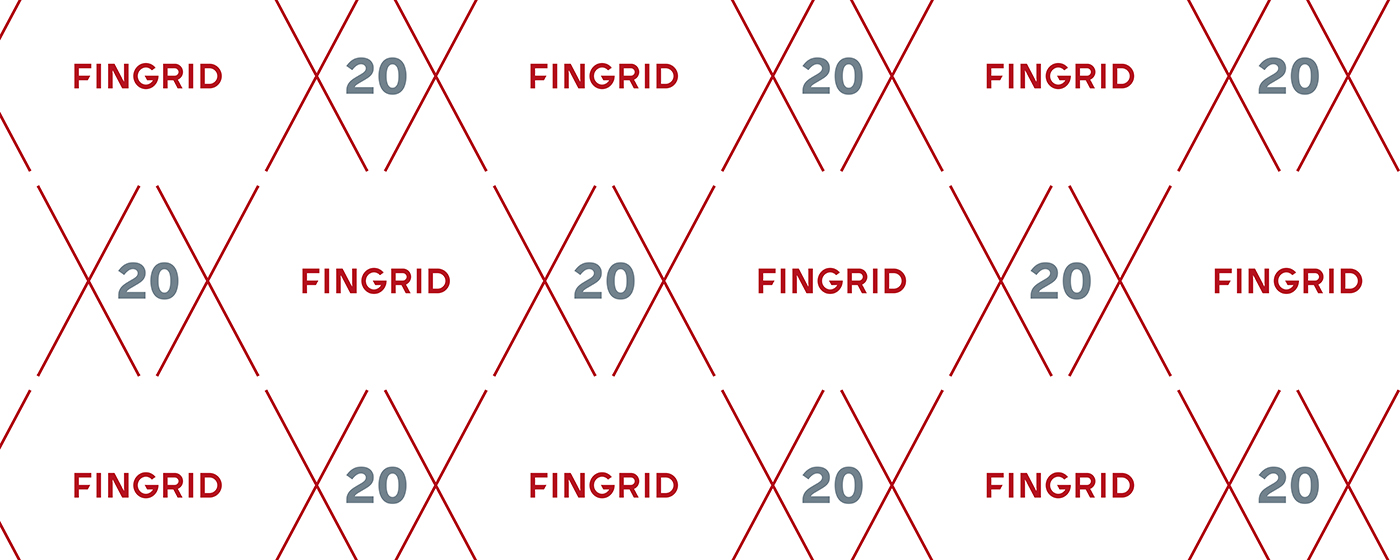The beginning
Suomen Kantaverkko Oy, now known as Fingrid Oyj, was founded on 29 November 1996. Operative activities at the company started on 1 September 1997. On the previous day, Imatran Voima Oy, Pohjolan Voima Oy and the State of Finland reached agreement on centralising the main grid business and power transmission networks into a single company. Worth more than one billion euros, this was the largest business deal in Finnish economic history at the time. Finland’s membership in the EU and the directive on opening up the electricity market, which required separation of electricity main grid transmission from electricity production and sales,had a major impact on the birth of the company.
Growth and cost efficiency
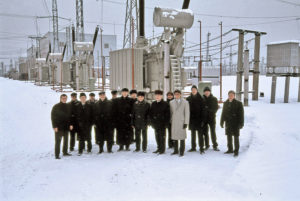
The company format was changed to a public limited company in order to facilitate the move to international capital markets in the early stage of operations. Funder confidence and a high credit rating made it possible to create a balanced capital structure for a company working in a capital-intensive area of business. The structure is still the same today, but shareholder’s equity is currently maintained at approximately 30%.
The reform of the EU Energy Market Act in 2011 meant that Fortum and Pohjolan Voima had to give up their ownership in Fingrid. A deal signed on 19 April 2011 made the State of Finland the largest owner of the company. Finnish pension insurance companies also became owners.
Over a two-decade period, the company’s turnover has nearly tripled to more than 600 million euros. Finland is also one of the 20 largest corporation tax payers in Finland.
Fingrid’s overall effectiveness is based on a business model in which services that can be procured in a market-based manner are outsourced, activities are centralised, digitalisation is productively utilised, and the personnel focuses on basic tasks in their areas of core competence. The effectiveness of Fingrid’s operations is also clearly reflected in the fact that the transmission prices applied by the company are among the lowest in Europe.
Working with customers
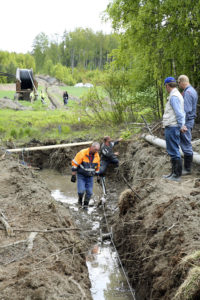
As a monopoly, Fingrid has the same contract terms and price structure for all of the customers connected to the grid. The largest customer group is electricity market actors. When selling and procuring electricity, they utilise the Nord Pool electricity exchange, which is partly owned by Fingrid, as well as security of supply and imbalance management. The most important large customers are industry and distribution system operators.
Customer cooperation is a central factor in company operations. With regard to main grid business, Fingrid has implemented an operating model of 12 regional grid plans that directly involves the customers for more than 10 years, with cooperation being handled in, for example, different advisory committees. The ongoing energy changes mean that experts will have to participate in customer work to a greater extent in the future.
Two billion euros for transmission capacity
Fingrid has been building the main grid, cross-border connections and the reserve power required during disturbances at a faster and faster pace. During its 20-year history, the company has invested nearly two billion euros in the main grid, two-thirds of that in the past ten years.
When all of the 110, 220 and 400 kilovolt voltage levels are included, nearly 3,000 kilometres of new transmission line has been constructed. The length of the current grid is approximately 14,200 kilometres, with 49,000 transmission line towers, 300 kilometres of submarine cables and 113 substations.
Important new projects have included replacement of the Rautarouva (“Iron Lady”) line, which was Finland’s first trunk line when it opened in 1929, and the construction of new reserve power plants in Olkiluoto and Forssa. In terms of euros, the biggest investments have been the FennoSkan 2 and EstLink 2 submarine cables, at a combined cost of 300 million euros. Fingrid has been recognised for its success in grid life cycle management on many occasions. The company has always ranked highly in the ITOMS international study of grid maintenance.
The fact that, in terms of monetary value, investments over the past decade are equivalent to about half of the main grid that has been built during the 100-year history of high voltage transmission in Finland, provides a good picture of the company’s current investment level.
System security stands at 99.999%
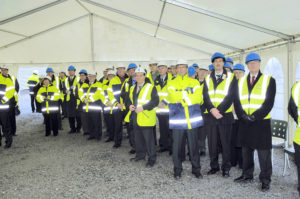
System security management is one of Fingrid’s main processes. Its most important target is to maintain a high level of transmission reliability. Maintaining the annual level of 99.999% that has been achieved is an extremely ambitious goal in an increasingly complicated power system operating environment.
Substations in Finland have been unmanned since the early 1980s with the introduction of operation control systems. A nationwide operation control system was implemented in 1997. In 2001, the Grid Control Centre took responsibility for grid management throughout Finland. Centralisation of operations was completed in 2013. The people responsible for the power system, grid management, balancing production and consumption and operational planning now work at the Main Grid Control Centre. These facilities allow for good information exchange and cooperation.
Each year, the Main Grid Control Centre handles the planning and implementation of nearly 2,500 switching schedules, operates in the electricity market, procures loss electricity from the electricity exchange and is responsible for procuring reserves to maintain the power balance, frequency and disturbance readiness.
Electricity market borders open up
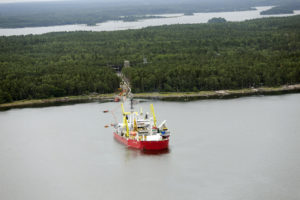
Cross-border tariffs on Fingrid’s Nordic connections were phased out in 1999, and Finland became part of the Nordic electricity market as a separate price area. FennoSkan2 from Rauma to Dannebo in Sweden was completed in 2011 in cooperation with Svenska Kraftnät, and raised transmission capacity to 2,700 megawatts in both directions.
On the eastern border, Russian import reached record levels in 2001 as a result of a contract signed with RAO EES Rossii. Completion of a third 400 kilovolt cross-border interconnector from St Petersburg to Kymi via Vyborg in 2003 also increased imports. For nearly a decade, 11 terawatt hours of electricity was imported per year at full technical operating time. Today, import levels are about 4 terawatt hours per year.
EstLink 1 to Estonia opened in 2006. Cross-border capacity nearly tripled when EstLink 2, a 650 megawatt submarine cable connection, was completed in 2013 and the Baltic countries became part of the Nordic electricity market.
The combining of regional electricity markets during this decade has made Finland part of a market that has an annual volume of almost 3,000 terawatt hours and includes 19 countries and nearly all of Europe in geographic terms.
Fingrid’s subsidiary Fingrid Datahub Oy was founded in 2016 to manage the electricity market and retail market party information in particular.
An international and active player
Fingrid mostly handles domestic tasks, but its operations are very international by nature today.
Fingrid has played a major role in developing European electricity markets. It has been a member of the European Network of Transmission System Operators ETSO (now known as ENTSO-E) since the organisation was founded in 1999, agreeing on issues such as the removal of cross-border tariffs and mutual compensation for transit transmission. This system, in which some 400 million euros change hands, marked the beginning of real electricity market freedom in the entire European region.
Fingrid participates in international research activities in selected technical fields that are important to the company, such as the use of HVDC direct current technology in submarine cables. Comparison studies of best practices in main grid operation also require and facilitate an in-depth level of expert collaboration.
Fairness is one of the working community values
Fairness and efficiency were two of the company’s values when it was founded, and they are still included in Fingrid’s values today. Transparency, fairness, efficiency and responsibility were the outcome of the updated strategy work carried out with the personnel in 2016.
Fingrid’s strategy can be summarised in the slogan “Fingrid keeps the lights on in Finland and promotes market functionality through safe and effective investments.” The vision in terms of handling these tasks is to set an example for main grid operations.
Fingrid is an expert organisation with some 300 permanent staff. The company’s matrix organisation has been developed so that, along with the main processes, the customer, economic and personnel perspectives are also managed as equal entities.
Moving towards the future digitally
Fingrid’s operative activities are based on telecommunication and data system solutions that ensure efficiency, high usability and security. From the very beginning, Fingrid and its predecessors understood that investing in data and telecommunications systems and their innovative use would facilitate the company’s operative efficiency. Digitalisation has been a strong theme in main grid operations for a long time.
The electricity system as such already produces huge amounts of useful information that, when combined with data obtained from the operating environment and digitalisation innovations such as new analytics and visualisation, creates unprecedented opportunities. Fingrid is closely involved in all of this.
Fingrid is continuing along its career path as a company. In terms of main grid development, Finland’s fourth strong wave of construction is currently in progress. At the same time, we’re preparing to connect a carbon-neutral production network to the grid. These are examples of the challenges being resolved by different parties in the company – now and in the future. •
This history article was written by Matti Tähtinen, who has held several positions at Fingrid and been involved in developing and managing the company’s business ever since it was founded.

